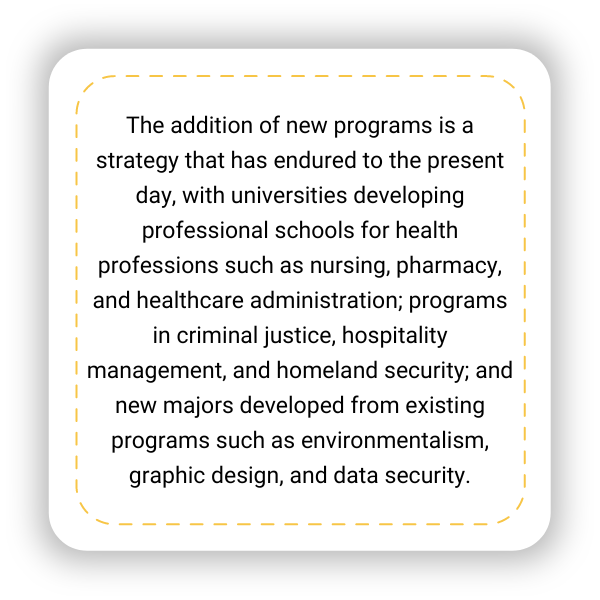College Enrollment: Cliffs, Shifts, and Lifts
Published by: WCET | 7/14/2023
Tags: Distance Education, Enrollment, Enrollment Shift, Managing Digital Learning, WCET
Published by: WCET | 7/14/2023
Tags: Distance Education, Enrollment, Enrollment Shift, Managing Digital Learning, WCET
This month, WCET will be focusing on enrollment trends and the impact those trends will have on higher education.
To kick off the theme, the WCET Steering Committee work group on enrollment joins us for the start of their Frontiers series on enrollment. We hope you enjoy the series and hope you will join us for our themed events happening this month. Thank you to the work group for this excellent series!
Enjoy the read and enjoy your day,
Lindsey Downs, WCET
Hundreds of colleges have closed since 2004, according to tracking by Best Colleges Most closures occurred in 2018, and the overwhelming majority of them (80%) were for-profit schools. Since the COVID-19 pandemic, Best Colleges has tracked 39 school closures or mergers. Of these schools, 64 percent (25 schools in total) had enrollments of less than 1,000 students; 23 percent (9 schools in total) had enrollments between 1,000 – 2,000; and the remaining 13 percent (5 schools in total) had enrollments over 2,000. The smaller enrollment schools were more likely to list economic concerns or enrollment issues as the primary reason for their closure or merger. Only two of the larger enrollment schools had unclear and sudden closures, while a third lost its accreditation.
While it is true that the overall enrollment of high school graduates in colleges and universities is dropping, enrollments are also shifting away from small, private institutions and for-profit institutions to larger, public, non-profit schools. There is also a gender and racial demographic shift happening with enrollments. In short, there are fewer college-bound students who are less likely to choose small for-profit schools and these students are more likely than in the past to identify as women and Latino.
Enrollments in U.S. colleges and universities have historically fluctuated, but this current drop in enrollments is not like previous ones. In this blog, we will share with you a historical overview of dips and surges in U.S. enrollment in higher education, and we will outline what makes the current enrollment situation different from previous ones.
According to the National Center for Educational Statistics (NCES), higher education in the U.S. began with a limited vision of who should receive a college education.
“When the federal Office of Education began collecting education data in 1869-70, only 63,000 students were attending higher education institutions throughout the country, which amounted to only about 1 percent of the 18- to 24-year-old population. This small number of students was divided among 563 campuses, giving an average enrollment size of only 112 students. About 21 percent of students were female” (Snyder et. al., 1993, pg. 64).
This NCES data point does not account for race or gender, although a healthy percent of enrollments were women, this should not be interpreted as widespread acceptance of female students on the part of the nation’s most prestigious institutions.

Postsecondary enrollments grew steadily in the post-Civil War era. The majority of students were white men attending both public and private institutions; many of which explicitly barred female and Black students. However, newly established schools catering to these untapped student markets began to change who was able to get a college education in the United States. There were significant gains in the female collegiate population at schools that accepted applications from women, such as Oberlin College in Ohio, and land grant institutions in the Midwest and West that only allowed women to enroll to secure the financial viability of the school (Thorne, 1985). With the establishment of the Seven Sisters, Mount Holyoke College (1837), Vassar College (1861), Smith College (1875), Wellesley College (1875), Bryn Mawr College (1885), Radcliffe College (1879), and Barnard College (1889), white women finally had schools of their own. Schools to train Black students in trades and as educators were established quickly after the end of the Civil War. “The majority of HBCUs originated from 1865-1900, with the greatest number of HBCUs started in 1867, two years after the Emancipation Proclamation: Alabama State University, Barber-Scotia College, Fayetteville State University, Howard University, Johnson C. Smith University, Morehouse College, Morgan State University, Saint Augustine’s University and Talladega College.”
According to the National Center for Educational Statistics (NCES), higher education in the U.S. began with a limited vision of who should receive a college education.
“When the federal Office of Education began collecting education data in 1869-70, only 63,000 students were attending higher education institutions throughout the country, which amounted to only about 1 percent of the 18- to 24-year-old population. This small number of students was divided among 563 campuses, giving an average enrollment size of only 112 students. About 21 percent of students were female” (Snyder et. al., 1993, pg. 64). This NCES data point does not account for race or gender, although a healthy percent of enrollments were women, this should not be interpreted as widespread acceptance of female students on the part of the nation’s most prestigious institutions.
At the turn of the century, the high rate of immigration to the U.S. contributed to steady gains in college enrollment, although only 2% of the population earned a postsecondary degree. Colleges that began offering programs for professional training—such as business, accounting, engineering, and teaching—enjoyed enrollment bumps due to the popularity of these degree programs.
In the 1920s, enrollments dipped for women and slowed for all populations during the years of the Great Depression. In the 1940s, it was men who left or deferred college for military service. This was the first big dip in enrollments during the modern era. However, thanks to the 1944 G.I. Bill, enrollments of white males surged after World War II. After the passage of the 1965 Immigration Act, new immigrants and international students bolstered enrollment, even as the nation’s birth rate began to drop. Additionally the 1965 Higher Education Act additionally opened new markets of students by providing a subsidy now known as the Pell Grant: a grant created for low-income students to be able to afford a college education.
The big story in the 1970s was the drop in male college enrollment. In 1969, 33 percent of high school men enrolled in college, but, by 1980, only 26 percent of high school men enrolled. What prevented this enrollment dip from being an enrollment cliff was high school women, whose enrollment in college jumped from 21 percent to 25 percent, and it has only continued to increase (aside from periodic dips through 2005). In fact, in the 1980s, women began to outnumber male students enrolled in college, and today women make up nearly 60 percent of all college enrollments.
The surge of women in postsecondary education programs in the 1980s led to fewer college age students in the current period. Birth rates have been incrementally falling in the U.S. since the late 1960s, with a slight peak in 2006-2007, followed by a faster decline through 2022. Because women with a college education tend to have fewer children than women without a college education, sociologists suggest that the declining birth rate is due to fewer years in their lifetime when women consider pregnancy.
Another new market of students opened up around the 2000s, with college programs designed specifically for adult students who held jobs and had children. An important development coinciding with this new market was online education, driven by the development of new schools like Western Governors University and the University of Phoenix, and the expansion of online branches of existing schools like Southern New Hampshire University and the University of Maryland University College (now University of Maryland Global Campus). Currently, 11 percent of postsecondary institutions in the U.S. offer primarily online degrees, and 14 percent of undergraduate students are enrolled in primarily online programs.
For 150 years, U.S. colleges and universities have increased college enrollments by:
But the impending drop in enrollment feels different this time. The U.S. birth rate has been declining for fifteen years, and it is lowest in families who can afford to send their children to college without loans. College costs continue to rise, and subsidies continue to shrink, making college unaffordable for low-income and middle-class families. Outside of adults without a college credential, there are few new markets of students to boost the lost enrollments.
Although they’ve been rising steadily since the 1970s, tuition and fees skyrocketed in the generation between Gen X attending college and when Gen Z attended college. From 1992 to 2022, tuition and fees rose 80.24 percent at private nonprofit institutions; 124.64 percent at public 4-year institutions; and 64.96 percent at public 2-year institutions. At the same time, state support for public institutions has plummeted.

“Overall state funding for public two- and four-year colleges in the 2017 school year (that is, the school year ending in 2017) was nearly $9 billion below its 2008 level, after adjusting for inflation. The funding decline has contributed to higher tuition and reduced quality on campuses as colleges have had to balance budgets by reducing faculty, limiting course offerings, and in some cases closing campuses. At a time when the benefit of a college education has never been greater, state policymakers have made going to college less affordable and less accessible to the students most in need” (Mitchel et. al, 2017). Student debt has been cited as a major reason for low home ownership and higher reliance on government relief programs among college graduates, even 20 years after earning their degree. It is leading high school students and their families to question the value of a college credential.
A 2021 survey of high school students by the ECMC Foundation found that fewer than half were interested in a four-year college degree (down from 71 percent), and 65 percent cited the cost of college as an important factor in their decision to attend college, while 43 percent cited the cost of college as the most important factor in their decision. A more recent survey by Gallup and Lumina Foundation found that “Financial barriers are most frequently identified as very important reasons unenrolled adults are not currently enrolled, including costs of programs (55%), inflation (45%) and the need to work (38%).” (Gallup and Lumina, 2023).
Another aspect of the enrollment woes being experienced by many institutions relates to international students and immigration. International students often pay full tuition, making them an attractive market for tuition-driven institutions (versus in-state students who may pay significantly less tuition dollars). However, travel restrictions arising from the COVID-19 pandemic led to a significant drop in international student enrollment in U.S. schools in the 2020/2021 and 2021/2022 academic years.
International student enrollment is making a comeback from the 46 percent drop in the 2020/2021 academic year, but it is still only 87 percent of the number of international students who were enrolled in 2019/2020.
Immigration to the United States also slowed between 2017 – 2021.
“Legal permanent and temporary immigration rose in 2022 after a few years of chill brought about by the COVID-19 public-health crisis and the Trump administration’s restrictive policies and rhetoric. Amid crises around the world, the Biden administration extended or expanded Temporary Protected Status (TPS) for certain eligible immigrants already in the United States and announced special humanitarian parole programs allowing some migrants from several countries to enter the United States and stay temporarily” (Ward & Batolova, 2023).
“Of the 19 million students at U.S. colleges and universities in 2018, 28 percent were either first-generation immigrants or the children of immigrants. Together, these immigrant-origin students play an important role in postsecondary enrollment across the country, accounting for 58 percent of the growth of the student population between 2000 and 2018” (Batalova & Feldblum, 2020).
While institutions may have been able to anticipate enrollment declines among international students and immigrants due to the political climate, they could not have prepared for the greater impact of a global pandemic on their enrollments.
Decreased college enrollment is not simply a matter of falling birthrates shrinking the market of new students: high school graduates who would attend college. The current “enrollment cliff” is the perfect storm of decades of states scaling back funding of public colleges and universities, skyrocketing tuition and fees, a decline in birthrates, a slowing of immigration (which contributed to enrollment rises in the early 1900s and in the 1960s), a global pandemic which added to economic instability, a drop in international students, and young adults questioning the value of a postsecondary degree over the burden of debt.
Schools preparing to meet the challenges of the decline in high school enrollments, which are expected to peak in 2025, will need to pay attention to changing racial demographics. Among white students, the projected decline is four million; 700,000 among Black students; and 100,000 among Native American/Alaskan Native students. During this same period, there is a projected rise of 3.5 million in high school enrollment for Latino students.

As noted earlier, over the course of the last 150 years, colleges established for young, white men began enrolling students they previously had banned, including women and students of color. Until recently, the expectation of these colleges was that students must adapt to the institution and not the other way around. Title III of the Higher Education Act of 1965 and subsequent amendments have provided recognition and funding for Alaska Native and Native Hawaiian-serving institutions (ANNH), Native American Serving Nontribal Institutions (NASNTI), predominantly black institutions (PBI), and Minority Serving Institutions (MSI). Title V provides recognition and funding for Hispanic Serving Institutions (HSI). In this way, schools have an incentive to provide programs for specific populations of students for whom the institution was not originally designed. However, the demographic shift of students will require colleges to go much further than special programs and scholarships for historically excluded students, who will make up demographic majorities in the coming years.
The scarcity of students enrolling in post-secondary institutions will create a buyer’s market in which students are able to demand more for their tuition dollars. What do students want from college? In poll after poll, affordability, and career readiness are the top considerations that students have when choosing college (see this poll from the National Student Clearinghouse, or the Princeton Review, or Georgetown University). In fact, according to the article about the results from the National Student Clearinghouse, which took a poll of high school students, 60 percent prefer to enroll in career specific programs versus programs balanced with or focused on a liberal arts education.
According to an Every Learner Everywhere report, students want an education that feels relevant to who they are and what they want from life. The report lists the three main takeaways that encapsulate students’ desire for relevance:
Students who participated in the What Our Best College Instructors Do report that the most meaningful educational experiences involved feeling a sense of belonging, learning by doing, and having clear expectations from faculty about assignments. How relevant their education feels to their personal growth and to their professional readiness matters in terms of the value students attach to it.
A study conducted between 2018 – 2020 on student perception of digital learning courseware found that value for students is not simply a matter of cost, but of the intersection of cost and effectiveness in helping students achieve their goals. In other words, students don’t mind paying educational costs (to a degree) as long as that education leads to the career and lifestyle that students desire.
For institutions unable to make the changes needed for this new era of market scarcity, the drop in enrollment is a cliff they may not survive. But those institutions that have the resources and the enrollment numbers to survive are not entirely in the clear, as they will face an enrollment shift that will challenge business as usual.
This month on WCET Frontiers the WCET Steering Committee Working Group focused on enrollment will be providing two additional posts. This series will explore the shifts of enrollment, how higher education institutions in the U.S. are responding to these shifts, and the impact of digital learning on enrollment. Thank you to the members of the work group for all of the work on this topic and for co-authoring this article.
Batalova, J. and Feldblum, M. (2020).
Immigrant-Origin Students in U.S. Higher Education: A Data Profile. The Online Journal of the Migration Policy Institute. https://www.migrationpolicy.org/research/immigrant-origin-students-us-higher-education
Gallup and Lumina Foundation. (2023) The State of Higher Education 2023. https://www.gallup.com/analytics/468986/state-of-higher-education.aspx
Snyder, T., Alexander, L., Ravitch, D., Elliott, E. (1993). 20 Years of American Education: A Statistical Portrait. U.S. Department of Education Office of Educational Research and Improvement. Accessed from: https://nces.ed.gov/pubs93/93442.pdf
Thorne, Alison Comish. (1985). “Visible and Invisible Women in Land-Grant Colleges, 1890-1940” (1985). Faculty Honor Lectures. Paper 2. https://digitalcommons.usu.edu/honor_lectures/2
Mitchell, M., Leachman, M, and Masterson, K. (2017). A Lost Decade in Higher Education Funding. Center on Budget and Policy Priorities. https://www.cbpp.org/research/state-budget-and-tax/a-lost-decade-in-higher-education-funding
Ward, N., and Batalova, J. (2023).
Frequently Requested Statistics on Immigrants and Immigration in the United States. The Online Journal of the Migration Policy Institute. https://www.migrationpolicy.org/article/frequently-requested-statistics-immigrants-and-immigration-united-states
WCET Steering Committee, Executive Director, Iowa Community College Online Consortium
WCET Steering Committee Chair, WCET Executive Council, Assistant Vice Provost, Online Learning and Innovation, The Ohio State University (Re-elected October 2022)
WCET Steering Committee, Assistant Dean, Digital Learning, The Pennsylvania State University